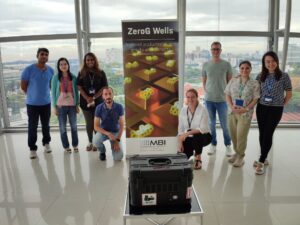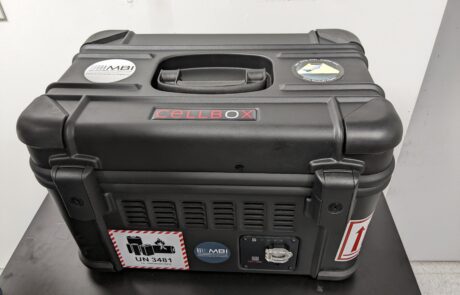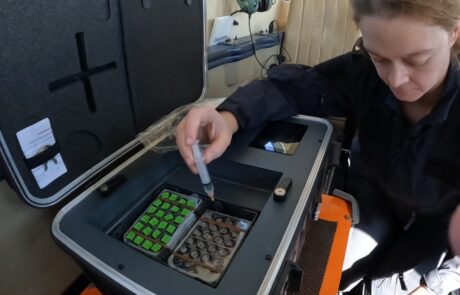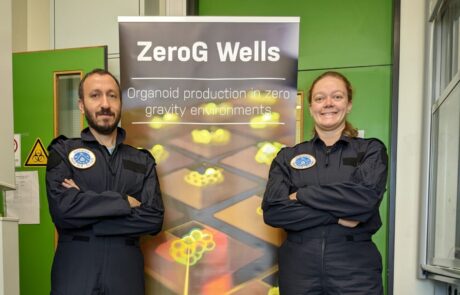Zero-G Wells: Taking mechanobiology into space
Humanity has always looked to the stars to wonder what lies beyond our planet. But space is also dark, dangerous and full of unknowns. With the searing cold, scorching radiation, smothering lack of air and shortfall of gravity, every space expedition carries its perils. How can we continue pushing the limits of space venture without the risk of anyone pushing up the daisies?

The Zero-G Well team preparing to ship organoids to Zurich (L-R: Jegan Shanmugarajah, Mona Suryana, Suburnisha Binte Mohamed Raffi, Gianluca Grenci, Anne Beghin, Florian Dilasser, Esra Karatas, Kalista Bong)
Singapore’s first large scale biomedical space endeavour may just present the answer to this question. In October of 2022, a zero-gravity flight with thousands of living “passengers” from Singapore was launched. Who are these passengers? Human organoids, which are miniature versions of actual human organs. Organoids can be carefully crafted to replicate different functions of their original human counterparts, so that scientists can observe how organs develop and work under certain conditions. For example, lung organoids are used to study how oxygen and carbon dioxide exchanges occurs during breathing, and organoids are being used for studying human disease or drug testing.
From the lab to the skies
Earlier in 2022, a collaborative research team at MBI combined their expertise in imaging, microfabrication, and organoid biology to develop JeWells, a ground-breaking all-in-one platform consisting of specialised microfabricated containers (or wells) that enable simultaneous growth, imaging, and analysis of up to thousands of organoids. This team was led by Research Asst. Profs. Anne Beghin, Gianluca Grenci, and Assoc. Prof. Virgile Viasnoff from the Mechanobiology Institute, National University of Singapore and the study published in Nature Methods. With the capability to produce and maintain human organoids at scale, JeWells have the potential to replace animal testing.
However, Anne also realised that JeWells could go in another direction – vertically into space! With her long-term interest in space exploration and her knowledge in mechanobiology, she thought the JeWell platform could be a perfect instrument to investigate the effects of zero-gravity on human tissues, and indeed, this idea was confirmed after several discussions with experts in the field from the National Aeronautics and Space Administration (NASA) and other space agencies. From examining astronauts before and after a space mission, we know that living in a low or zero-gravity environment leads to a loss of muscle mass and bone density. Astronauts can also experience vision problems as the lack of gravity leads to fluids moving upwards to the head and compressing the eye. The space experts agreed that using JeWells to grow organoids is an innovative way to explore the effects of zero-gravity. In particular, the pyramidal shape of JeWells provides a contained 3D environment so that organoids can develop in zero-gravity without loss of liquids or cells. As JeWells can be used to grow thousands of organoids simultaneously, scientists would be able to setup and run multiple controlled experimental scenarios, compared to the small numbers of astronauts who can be examined by doctors. This knowledge would be invaluable for understanding how human organs cope with zero-gravity and how this can be overcome for future manned space missions. Inspired by this feedback, Anne and Gianluca began adapting JeWells into Zero-G Wells to see if their technology platform could be used to grow organoids in micro or zero-gravity.
Taking a stab in the dark with her scientific vision, Anne looked around for partners and advice for her project. Ultimately, she found collaborators Prof. Oliver Ullrich and Dr. Cora Thiel, at the University of Zurich (UZH) Space Hub, who saved her a seat on their airplane for their 6th Swiss Parabolic Flight Campaign — an aerospace programme which takes experiments, literally, to a whole other level, into an environment devoid of gravity.
With the gravity part down, the research team had to find a method to securely transport of their experiments and human samples from their lab in Singapore to the space hub in Switzerland, but also to ensure organoids stability during the zero-gravity flight. They found a partner with CellBox Solutions, a biotech company which produces a self-sufficient cell incubator that maintains optimal temperature and CO2 concentration that can be used on aeroplanes.
After months of preparation, Anne and Gianluca, with their portable cell incubator on board, were ready to take to the skies. Their plane began its ascent on a sharp incline (around 60º) and thrust before nose-diving, plunging everything on board into weightlessness. For a minute, the scientists and their organoid samples within were severed from the hold of gravity. Anne described the sensation as ‘a complete freedom and easiness of movements in all three dimensions that was surprisingly very comfortable, but you could not make heads or tails of yourself and the only indication of the direction or angle of the plane was the through the cockpit window’ — in which you could see the ground drawing closer as the plane careened towards the earth.
Each combined ascent and descent of the plane makes one “parabola”. In between parabolas, Anne and Gianluca had to unstrap themselves, open the incubator and add chemicals to the organoids to lock them physiologically in a fixed and secured state, to be analysed back in the lab. After 15 repeated rounds of parabolas, the plane finally touched down and everybody was back safely on terra firma again.
After safely transporting themselves and their organoids back to Singapore, the research team are currently in the process of checking and analysing the organoids to see if there were any biochemical or mechanical aftereffects of zero-gravity exposure. However, the Zero-G Well experiment has already spurred further space-related collaborations within Singapore – in particular, new technological approaches for simulating micro-gravity conditions in ground-based laboratory facilities are being designed in partnership with Prof. Konstantin Novosolev, Director of the Institute of Functional Intelligent Materials (I-FIM) at NUS.
Zero-gravity effects on human biology
This Zero-G Well experiment was the first Singapore-led zero-gravity flight using live human samples. Across the globe, academic research groups, international space agencies such as NASA, the European Space Agency (ESA), and the Japan Aerospace Exploration Agency (JAXA), and private sector space companies share a deep interest in space-related biological experiments. While exposure to zero-gravity is often thought to be detrimental to the human body, new research suggests that micro and zero-gravity may have some benefits. A recent study looking at human cardiomyocytes (the cells responsible of the contraction of the heart) grown on the International Space Station (ISS) revealed that zero gravity improved not only the proliferation of cardiomyocyte, but also resulted in increased structure and cardiac function. Understanding how zero gravity affects human biology will not only benefit future space travellers but could also lead to applications for regenerative medicine and ageing for humans on Earth. The Zero-G Well team plan to conduct future trials on upcoming parabolic flights, with an eventual goal of having human organoids in Zero-G Wells orbiting Earth on the ISS within a few years.
Singapore and Space
In 2013, the Singapore Economic Development Board established the Office for Space Technology & Industry (OSTIn). As the National Space Office, OSTIn supports the development of talent and technologies for Singapore’s space sector and future workforce. Alongside OSTIn, there is a rapidly growing space ecosystem comprising of organizations such as Singapore Space & Technology Ltd, start-up and established technology companies, and academic research laboratories. Singapore is the first Southeast Asian country to sign the Artemis Accords, a US-led pact on space exploration that aims to promote peaceful, sustainable and beneficial use of space for all of humanity.
While the majority of space research projects in Singapore have typically revolved around satellite-related technologies, there is increasing interest in leveraging Singapore’s existing strength in life science research to support new space applications.






